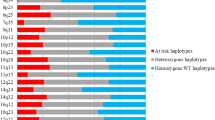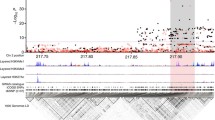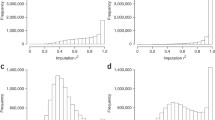Abstract
High-density oligonucleotide microarrays containing a large number of single nucleotide polymorphisms (SNPs) have enabled genome-wide association (GWA) analysis to become a reality. We used the early access Affymetrix Mendel Nsp 250K chips in a GWA case–control pilot study to identify genomic regions associated with breast cancer. We included 30 randomly sampled incident invasive breast cancer cases aged <45 years without deleterious mutations in the BRCA1 or BRCA2 genes, and 30 population controls individually matched on age, ethnicity and geographical area. The overall genotype call rate was 97.13 ± 1.33% for controls and 97.48 ± 1.42% for cases. Comparison was made between cases and controls for 203,477 genotyped SNPs using (a) unconditional logistic regression (ULR), (b) conditional logistic regression (CLR) models with adjustment for the matched pairs, (c) allelic tests for single marker tests and (d) haplotype trend regression (HTR). Genomic control and EIGENSTRAT methods were used for correction of population stratification in appropriate models. We demonstrate the similarity and dissimilarity of results from different statistical analyses. We found several possible significant regions harboring biologically meaningful known candidate genes, such as genes encoding fibroblast growth factor, transforming growth factor, epidermal growth factor, and estrogen synthesis enzymes to be associated with early-onset breast cancer. In single marker analysis, none of the SNPs were statistically significant after correction for multiple testing. However, haplotype association tests, using 90730 tag-SNPs, suggested two regions in GLG1 and UGT1 genes retaining significance even after Bonferroni correction. Nevertheless, without systematic replication, findings from this pilot study, especially the associations of breast cancer in relation to specific SNPs, should be interpreted with great caution.




Similar content being viewed by others
Abbreviations
- SNP:
-
Single nucleotide polymorphism
- GWA:
-
Genome-wide association
- LD:
-
Linkage disequilibrium
References
Hall JM, Friedman L, Guenther C et al (1992) Closing in on a breast cancer gene on chromosome 17q. Am J Hum Genet 50(6):1235–1242
Wooster R, Neuhausen SL, Mangion J et al (1994) Localization of a breast cancer susceptibility gene, brca2, to chromosome 13q12-13. Science 265(5181):2088–2090
Loman N, Bladstrom A, Johannsson O, Borg A, Olsson H (2003) Cancer incidence in relatives of a population-based set of cases of early-onset breast cancer with a known brca1 and brca2 mutation status. Breast Cancer Res 5(6):R175–R186
Dite GS, Jenkins MA, Southey MC et al (2003) Familial risks, early-onset breast cancer, and brca1 and brca2 germline mutations. J Natl Cancer Inst 95(6):448–457
Pharoah PD, Day NE, Duffy S, Easton DF, Ponder BA (1997) Family history and the risk of breast cancer: a systematic review and meta-analysis. Int J Cancer 71(5):800–809
Collaborative Group on Hormonal Factorin Breast Cancer (2001) Familial breast cancer: collaborative reanalysis of individual data from 52 epidemiological studies including 58,209 women with breast cancer and 101,986 women without the disease. Lancet 358(9291):1389–1399
Easton D, Ford D, Peto J (1993) Inherited susceptibility to breast cancer. Cancer Surv 18:95–113
Hopper JL (2001) Genetic epidemiology of female breast cancer. Semin Cancer Biol 11(5):367–374
Oesterreich S, Fuqua SA (1999) Tumor suppressor genes in breast cancer. Endocr Relat Cancer 6(3):405–419
Rahman N, Seal S, Thompson D et al (2007) Palb2, which encodes a brca2-interacting protein, is a breast cancer susceptibility gene. Nat Genet 39(2):165–167
Seal S, Thompson D, Renwick A et al (2006) Truncating mutations in the fanconi anemia j gene brip1 are low-penetrance breast cancer susceptibility alleles. Nat Genet 38(11):1239–1241
Claus EB, Schildkraut J, Iversen ES Jr, Berry D, Parmigiani G (1998) Effect of brca1 and brca2 on the association between breast cancer risk and family history. J Natl Cancer Inst 90(23):1824–1829
Cui J, Antoniou AC, Dite GS et al (2001) After brca1 and brca2-what next? Multifactorial segregation analyses of three-generation, population-based Australian families affected by female breast cancer. Am J Hum Genet 68(2):420–431
Malone KE, Daling JR, Thompson JD et al (1998) Brca1 mutations and breast cancer in the general population: analyses in women before age 35 years and in women before age 45 years with first-degree family history. J Am Med Assoc 279(12):922–929
Antoniou AC, Pharoah PD, McMullan G et al (2002) A comprehensive model for familial breast cancer incorporating brca1, brca2 and other genes. Br J Cancer 86(1):76–83
Rahman N, Teare MD, Seal S et al (2000) Absence of evidence for a familial breast cancer susceptibility gene at chromosome 8p12-p22. Oncogene 19(36):4170–4173
Thomas DC, Witte JS (2002) Point: population stratification: a problem for case–control studies of candidate-gene associations? Cancer Epidemiol Biomarkers Prev 11(6):505–512
Risch N, Merikangas K (1996) The future of genetic studies of complex human diseases. Science 273(5281):1516–1517
Wang WY, Barratt BJ, Clayton DG, Todd JA (2005) Genome-wide association studies: theoretical and practical concerns. Nat Rev Genet 6(2):109–118
Hirschhorn JN, Daly MJ (2005) Genome-wide association studies for common diseases and complex traits. Nat Rev Genet 6(2):95–108
John EM, Hopper JL, Beck JC et al (2004) The breast cancer family registry: an infrastructure for cooperative multinational, interdisciplinary and translational studies of the genetic epidemiology of breast cancer. Breast Cancer Res 6(4):R375–R389
Chang-Claude J, Eby N, Kiechle M, Bastert G, Becher H (2000) Breastfeeding and breast cancer risk by age 50 among women in Germany. Cancer Causes Control 11(8):687–695
Reich DE, Goldstein DB (2001) Detecting association in a case–control study while correcting for population stratification. Genet Epidemiol 20(1):4–16
Price AL, Patterson NJ, Plenge RM et al (2006) Principal components analysis corrects for stratification in genome-wide association studies. Nat Genet 38(8):904–909
Zaykin DV (2004) Bounds and normalization of the composite linkage disequilibrium coefficient. Genet Epidemiol 27(3):252–257
Zaykin DV, Westfall PH, Young SS et al (2002) Testing association of statistically inferred haplotypes with discrete and continuous traits in samples of unrelated individuals. Hum Hered 53(2):79–91
Dempster AP, Laird NM, Rubin D (1977) Maximum likelihood from incomplete data via the em algorithm. J Roy Stat Soc B 39:1–38
Zaykin DV, Zhivotovsky LA (2005) Ranks of genuine associations in whole-genome scans. Genetics 171(2):813–823
Lambert GC (2007) Helixtree software version 6.0.2. Golden helix, Inc. http://www.goldenhelix.com.
Carlson CS, Eberle MA, Rieder MJ et al (2004) Selecting a maximally informative set of single-nucleotide polymorphisms for association analyses using linkage disequilibrium. Am J Hum Genet 74(1):106–120
Easton DF, Pooley KA, Dunning AM et al (2007) Genome-wide association study identifies novel breast cancer susceptibility loci. Nature 447(7148):1087–1093
Hunter DJ, Kraft P, Jacobs KB et al (2007) A genome-wide association study identifies alleles in fgfr2 associated with risk of sporadic postmenopausal breast cancer. Nat Genet 39(7):870–874
Stacey SN, Manolescu A, Sulem P et al (2007) Common variants on chromosomes 2q35 and 16q12 confer susceptibility to estrogen receptor-positive breast cancer. Nat Genet 39(7):865–869
Fackenthal JD, Olopade OI (2007) Breast cancer risk associated with brca1 and brca2 in diverse populations. Nat Rev Cancer 7(12):937–948
John EM, Miron A, Gong G et al (2007) Prevalence of pathogenic brca1 mutation carriers in 5 us racial/ethnic groups. J Am Med Assoc 298(24):2869–2876
Yamaguchi F, Morrison RS, Gonatas NK et al (2003) Identification of mg-160, a fgf binding medial golgi sialoglycoprotein, in brain tumors: an index of malignancy in astrocytomas. Int J Oncol 22(5):1045–1049
Cui Y, Liao YC, Lo SH (2004) Epidermal growth factor modulates tyrosine phosphorylation of a novel tensin family member, tensin3. Mol Cancer Res 2(4):225–232
Rakha E, Ellis I, Reis-Filho J (2008) Are triple-negative and basal-like breast cancer synonymous? Clin Cancer Res 14(2):618
Rakha EA, El-Sayed ME, Green AR et al (2007) Prognostic markers in triple-negative breast cancer. Cancer 109(1):25–32
Yeager M, Orr N, Hayes RB et al (2007) Genome-wide association study of prostate cancer identifies a second risk locus at 8q24. Nat Genet 39(5):645–649
Tommerup N, Vissing H (1995) Isolation and fine mapping of 16 novel human zinc finger-encoding cdnas identify putative candidate genes for developmental and malignant disorders. Genomics 27(2):259–264
Basu NK, Kubota S, Meselhy MR et al (2004) Gastrointestinally distributed udp-glucuronosyltransferase 1a10, which metabolizes estrogens and nonsteroidal anti-inflammatory drugs, depends upon phosphorylation. J Biol Chem 279(27):28320–28329
Elahi A, Bendaly J, Zheng Z et al (2003) Detection of ugt1a10 polymorphisms and their association with orolaryngeal carcinoma risk. Cancer 98(4):872–880
Huo D, Kim HJ, Adebamowo CA et al (2007) Genetic polymorphisms in uridine diphospho-glucuronosyltransferase 1a1 and breast cancer risk in africans. Breast Cancer Res Treat. doi:10.1007/s10549-007-9720-7
Acknowledgement
Support This work was supported in part by grants from the National Cancer Institute Grant # UO1 CA 122171. The authors wish to thank all the members of the Breast Cancer Family Registry (BCFR) and the German Breast Cancer Study (GBCS).
Author information
Authors and Affiliations
Corresponding authors
Rights and permissions
About this article
Cite this article
Kibriya, M.G., Jasmine, F., Argos, M. et al. A pilot genome-wide association study of early-onset breast cancer. Breast Cancer Res Treat 114, 463–477 (2009). https://doi.org/10.1007/s10549-008-0039-9
Received:
Accepted:
Published:
Issue Date:
DOI: https://doi.org/10.1007/s10549-008-0039-9




